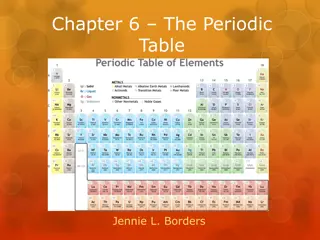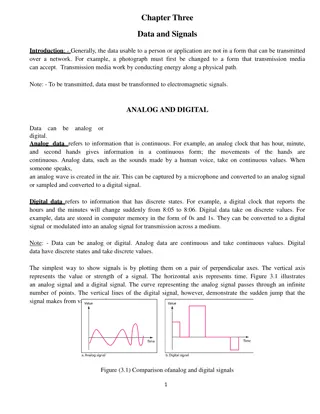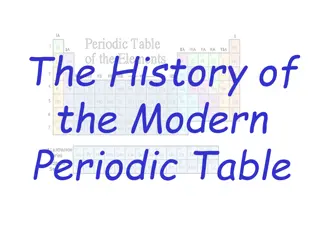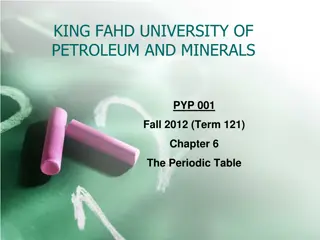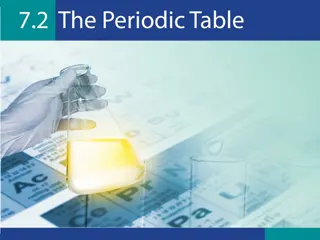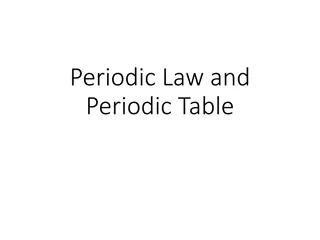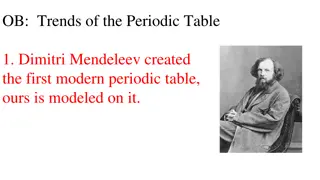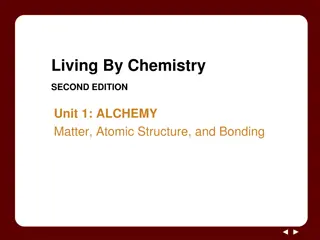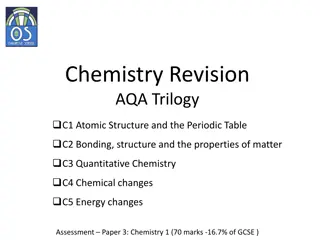Evolution of the Periodic Table: From Russian Chemist's Observations to Modern Classification
Russian chemist initially observed common properties in elements and arranged them by atomic mass, leading to the discovery of periodicity. English scientist later refined the arrangement by atomic number. The modern periodic table categorizes elements into groups with similar properties, based on atomic number and structure, highlighting distinctions between metals, nonmetals, and metalloids.
Download Presentation

Please find below an Image/Link to download the presentation.
The content on the website is provided AS IS for your information and personal use only. It may not be sold, licensed, or shared on other websites without obtaining consent from the author.If you encounter any issues during the download, it is possible that the publisher has removed the file from their server.
You are allowed to download the files provided on this website for personal or commercial use, subject to the condition that they are used lawfully. All files are the property of their respective owners.
The content on the website is provided AS IS for your information and personal use only. It may not be sold, licensed, or shared on other websites without obtaining consent from the author.
E N D
Presentation Transcript
Russian chemist Looked for common properties in elements Then arranged by atomic mass Noticed similar properties appeared at regular intervals periodic mass
English scientist Elements fit into patterns better if arranged by atomic number e.g. Te and I number
Metals Nonmetals Metalloids Transition metals good conductors, shiny Alkali metals most reactive metals Alkaline earth metals reactive metals Halogens most reactive nonmetals Noble gases don t react
Description of the Modern Periodic Table The vertical groups bring together elements with similar properties. The horizontal periods of the table are arranged in order of increasing atomic number from left to right. The groups are numbered at the top. and the periods at the extreme left in the periodic table on the inside front cover. The first two groups--the s block- and the last six groups--the p block-together constitute the main-group elements. The d-block elements are known as the transition elements. The f- block elements, sometimes called the innertransition elements, would extend tile table to a widlh of 32 members if incorporated in the main body of the table. The table would generally be too wide to fit on a printed page, and so the f-block elements are extracted from the table and placed at the bottom. The 14 elements following lanthanum (Z = 57) are called the lanthanides, and the 14 following actinium ( Z = 89) are called the actinides.
Question Which pair of elements would you expect to exhibit the most similar physical and chemical properties? As and Se Na and Cl As and Sb B and Be
Metals and nonmetals are distinguished by a collection of physical and chemical properties. Metalloids are elements that look like metals and in some ways behave like metals, but also have some nonmetallic properties.
Atomic Properties and Periodic Table The periodic trends of the following properties will be studied here. Atomic radius Metallic and Non-metallic character Ionization (energy) potential Electron affinity Electronegativity
The Size of Atoms Atomic Radius It is the distance from the centre of the nucleus to the outermost shell of an atom. The covalent radius is one-half the distance between the nuclei oftwo identical atoms joined by a single covalent bond. General definition The ionic radius is based on the distance between the nuclei of ions joined by an ionic bond. The metallic radius is one-half the distance between the nuclei of two atoms in contact in the crystalline solid metal.
157pm Covalent radius Na Na 186pm Metallic radius Na Na 99pm Ionic radius Na- Cl-
Metallic and Non-metallic Character Metallic character is the tendency of an element to lose electrons and form positive ions (cations). For e.g., alkali metals are the most electropositive elements. It is also known as electropositivity. The tendency of an element to accept electrons to form an anion is called its non- metallic or electronegative character. For e.g., chlorine, oxygen and phosphorous show greater electronegative or non-metallic character."
Trends across the period Metallic character of elements decreases as we move to the right. Elements to the left have a pronounced metallic character while those to the right have a non-metallic character. Non-metallic character increases from left to right.
Why does the metallic character decrease from left to right across the period? The elements to the left of the periodic table have a tendency of losing electrons easily as compared to those to the right. As we move from left to right of the period, the electrons of the outer shell experience greater pull of the nucleus. This greater force of attraction is because the nuclear charge increases and the size of the atom decreases from left to right.
Why does metallic character increase down the group? As we move down the group the number of shells increases. This causes the effective nuclear charge to decrease due to the outer shells being further away: in effect the atomic size increases. The electrons of the outermost shell experience less nuclear attraction and so can lose electrons easily thus showing increased metallic character.
Ionizationenergy (IE). The amount of energy required to remove the most loosely bound electron from an isolated gaseous atom is called ionization energy (IE). It is measured in the units of electron volts (eV) per atom or kilo joules per mole of atoms (kJ mol-1).
Factors Governing Ionization Energy Size of the atom/ distance of the valence electron to the nucleus the nuclear charge Screening effect of the inner electrons Size of the atom As the size of the atom increases the outermost electrons are held less tightly by the nucleus (attractive force between the electron and the nucleus is inversely proportional to the distance). As a result it becomes easier to remove the electron and therefore the ionization energy decreases with the increase in atomic size.
Charge on the nucleus The attractive force between the nucleus and the electron increases with the increase in nuclear charge making it more difficult to remove an electron. The ionization energy thus increases with the increase in the nuclear charge.
Screening effect In multielectron atoms, the outermost electrons are shielded or screened from the nucleus by the inner electrons. The outer most electrons do not feel the complete charge of the nucleus. When the inner electrons are more, the screening effect will be large, the nuclear attraction will be less. Thus when the inner electrons increase the ionization energy will decrease.
Variation along a period The ionization energy increases with increasing atomic number in a period. This is because The nuclear charge increases on moving across a period from left to right. The atomic size decreases along a period though the main energy level remains the same. Due to the increased nuclear charge and simultaneous decrease in atomic size, the valence electrons are more tightly held by the nucleus. Therefore more energy is needed to remove the electron and hence ionization energy keeps increasing.
Variation down a group The ionization energy gradually decreases in moving from top to bottom in a group. This is due to the fact that: The nuclear charge increases in going from top to bottom in a group. An increase in the atomic size due to an additional energy shell (level) 'n'. Due to the increase in the number of inner electrons there is an increase in the shielding effect on the outer most electron. The effect of increase in atomic size and the shielding effect is much more than the effect of increased nuclear charge. As a result , the electron becomes less firmly held to the nucleus and so the ionization energy decreases as we move down the group.
Successive ionization energies The energies required to remove subsequent electrons from a gaseous atom is called as successive ionization energies. They are termed as first ,second, third ionization energy depending on the removal of the first, second, third electron respectively.
Successive ionization energies The second ionization energies are higher than the first due to the fact that after the removal of the first electron the atom changes into a monovalent positive ion. In this ion, the number of electrons decreases but the nuclear charge remains same and so the remaining electrons are held more tightly by the nucleus and it becomes difficult to remove the second electron. Hence the value of the second ionization energy (IE2) is higher than the first (IE1).
Electron affinity Electron affinity is the amount of energy released when an electron is added to an isolated gaseous atom. Electron affinity is the ability of an atom to hold an additional electron. If the atom has more tendency to accept an electron then the energy released will be large and consequently the electron affinity will be high. Just like a strong magnet
Factors affecting electron affinity When the nuclear charge is high there is greater attraction for the incoming electron. Therefore electron affinity increases as the nuclear charge increases. With the increase in the size of the atom the electron affinity decreases because the distance between the nucleus and the incoming electron increases. Electron affinities are low or almost zero in elements having stable electronic configurations (half filled and completely filled valence subshells) because of the small tendency to accept additional electron.
Variation along a period The size of an atom decreases and the nuclear charge increases on moving across a period. This results in greater attraction for the incoming electron. Hence the electron affinity increases in a period from left to right Variation down a group As we move down a group the atomic size and nuclear size increases. As the effect of increase in atomic size is more pronounced the additional electron feels less attracted by the large atom. Consequently the electron affinity decreases.
Electronegativity. This the relative tendency of an atom in a molecule to attract a shared pair of electrons towards itself. The value of electronegativity of an element describes the ability of its atom to compete for electrons with the other atom to which it is bonded.
Variation along a period As the nuclear charge increases from going left to right in a period because the electrons enter the same shell, the shielding is less effective. Thus the increased nuclear charge attract the shared pair of electrons more strongly resulting in higher electronegativity from going left to right in a period. Variation down the group Electronegativity decreases down the group because the atomic size increases. The larger the size of the atom the lesser the tendency to attract the shared pair of electrons.
What happens if two atoms of equal electronegativity bond together? Consider a bond between two atoms, A and B. If the atoms are equally electronegative, both have the same tendency to attract the bonding pair of electrons, and so it will be found half way between the two atoms. To get a bond like this, A and B would usually have to be the same atom. Example, H2, O2, Cl2 molecules. This type of covalent bond is described as a non-polar covalent bond.
Polar covalent bond This is the bond between two unlike atoms, which differ in their affinities for electrons. When a covalent bond is formed between two atoms of different elements, the bonding pair of electrons will lie more towards the atom, which has more affinity for electrons. The electron pair do not lie exactly midway between the two atoms. The atom with higher affinity for electrons develops a slight negative charge and the atom with lesser affinity for electrons, a slight positive charge. Such molecules are called 'polar molecules'.
In the hydrogen chloride (HCl) molecule, the bonding of hydrogen and chlorine atoms lies more towards Cl atom (because Cl is more electronegative) in the shared pair of electrons. Therefore, Cl atom acquires a slight negative charge, and H atom a slight positive charge. This causes the covalent bond between H and Cl to have an appreciable ionic character. The compounds having polar bonds are termed polar compounds. Polar substances in their pure forms, do not conduct electricity, but give conducting solutions when dissolved in polar solvents.
The greater is the difference in the electronegativity values of the combining atoms, greater is the polar character in the bond so formed. For example, in the series H - X (X=F, Cl, Br,I), the electronegativity difference between H and X atom follows the order: H- F > H - Cl > H - Br > H - I Therefore, the polarity in the H - X bond follows the order - F > H - Cl > H - Br > H I i.e., H - F bond is the most polar and H -I bond is the least polar in this series of compounds.
Periodic Properties of the elements Atomic Properties Electron affinity Ionization energy metallic character Ionization energy Atomic radius Electron affinity Atomic radius Atomic properties and the periodic table a summary
This powerpoint was kindly donated to www.worldofteaching.com http://www.worldofteaching.com Is home to well over a thousand powerpoints submitted by teachers. This a free site. Please visit and I hope it will help in your teaching




